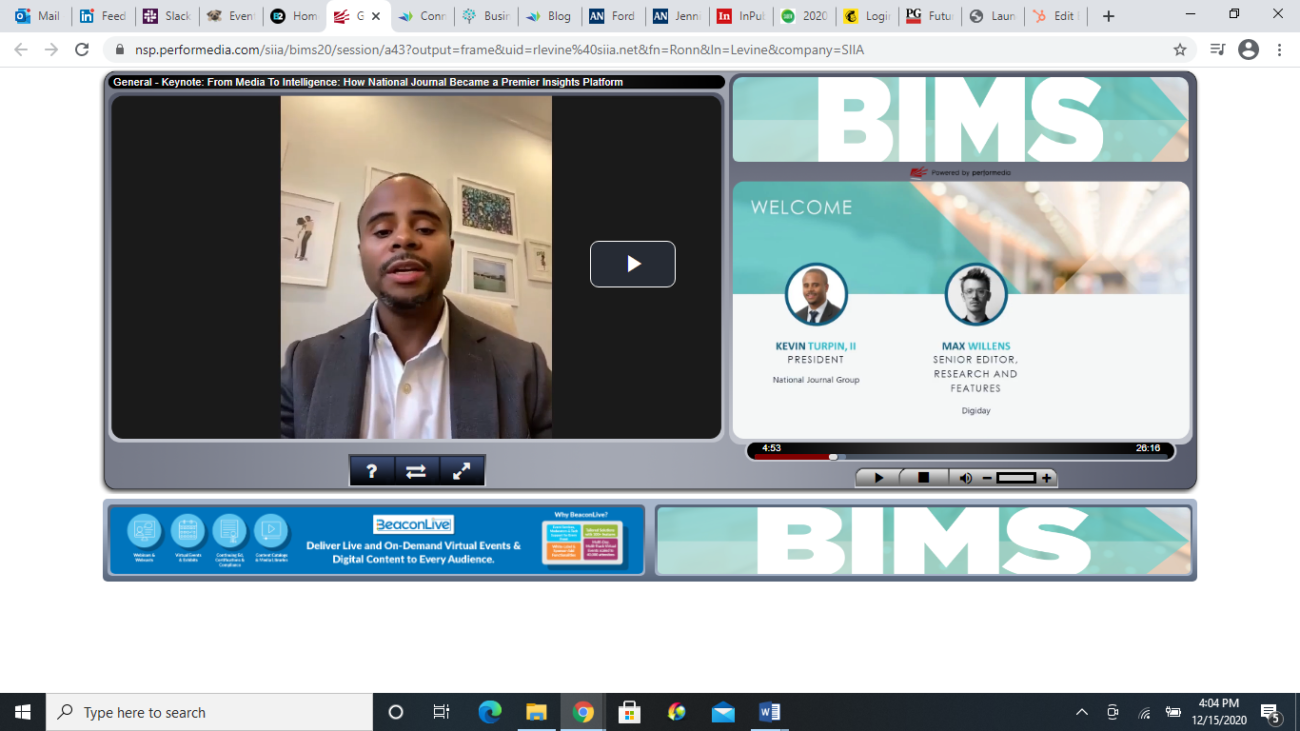In his keynote at BIMS 2020 two weeks ago, National Journal president Kevin Turpin spoke about the transformation that his company underwent 10 years ago, from publisher to information services organization. “There were a number of strategic things we did to get here today,” he said. Foremost in that was asking the right questions.
“We had a really deep dedication to getting to know our audience as best we could,” Turpin said. “Knowing what their top challenges are, how those challenges are changing? ‘What are the new things that are getting into your budget that wasn’t there five years ago? How are you managing the office differently?’
“We spent a year with our customers, asking them a set of questions over and over. The most important one was, ‘What keeps you effective?’”
Previously, Turpin had spoken more broadly about transformation. “When businesses are trying to recreate themselves and change, they spend too much time inside, in strategy meetings, batting around ideas that they think will work. We don’t spend enough time going around. How are [our customers’] jobs changing? What are they thinking about? What are they investing in this year? This will give you solutions.”
Of course, “going around” means something different these days—phone, Zoom, social media, Slack. But the idea of asking important questions of your customers remains paramount. Sales consultant Ryan Dohrn just wrote about this in an article on Editor & Publisher, saying “What keeps you up at night?” just isn’t good enough anymore.
“Your questions simply have to be better. One of your main questions that makes me nuts and that I hear in my ad sales training is this: ‘Tell me more about your business.’ C’mon, you’re better than that… And then, ‘What’s your budget?’ You can do better than that.
“Those are three questions we do need to ask, but maybe ask them in a more vibrant kind of way so that we don’t sound like every other media salesperson that’s calling on that customer,” Dohrn wrote.
I recall another sales consultant who liked to visit the offices of her clients and observe what sat on top of customers’ desks—that would tell what projects were most important. That also can’t happen now, of course, though we can see what books might be on someone’s shelves or what hangs on their walls.
“Here are four [questions] that I really like to ask,” Dohrn continued.
- “When you agreed to meet with me, what business challenge or problem were you hoping that I could help you solve?”
- “If I could give you a magic wand that you wave, what business challenge could I help you solve?”
- “When you think about competing here in our community or others in your competitive set, do you want to be seen as having some sort of a presence out there? Do you want to be competitive? Or do you want to be dominant?” (He said that the three options will lead him towards a budget that’s more actual.)
- “If everything went perfectly with your marketing campaign with me, what would the perfect end result be for you?” or “If I’m going to keep you for a lifetime as a customer, what do I need to do?”
Number four is interesting because we just had an events panel speak at BIMS, and much of their advice was knowing what results you want to see from your event before scripting it.
In a 2020 Association Benchmarking Report, only 38% of respondents said they are conducting communication-specific surveys at least once every 12–24 months to stay on top of members’ needs. And only half believe they have a good understanding of their reader, member and advertiser needs.
“What’s the first question [customers] ask you every time you check in?” Turpin asked. “Those top three feed into ideation. Let’s take the challenges of what we learned in spending time with top clients. This is where our transformation is going to go.”



 Get creative with Zoom. I mentioned this Friday but didn’t show the picture. The Editorial Freelancers Association held a virtual chapter meeting in October. “We are getting the hang of this new format and took advantage of Zoom’s features to maximize our time together.” Nothing special there, but the accompanying photo of participants is not the Brady Bunch boxes that we always see, but The Hollywood Squares! Can a Match Game or Family Feud configuration be next?
Get creative with Zoom. I mentioned this Friday but didn’t show the picture. The Editorial Freelancers Association held a virtual chapter meeting in October. “We are getting the hang of this new format and took advantage of Zoom’s features to maximize our time together.” Nothing special there, but the accompanying photo of participants is not the Brady Bunch boxes that we always see, but The Hollywood Squares! Can a Match Game or Family Feud configuration be next?





